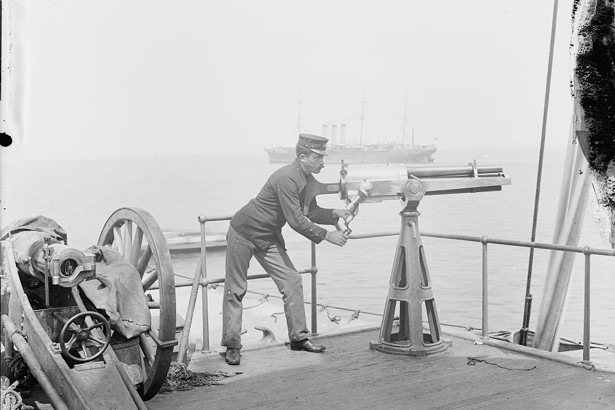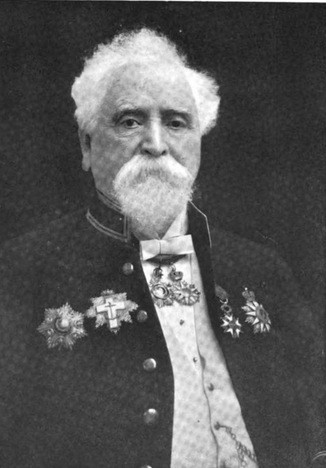
Hiram Maxim didn’t set out to invent a killing machine. But a lifetime of tinkering and building eventually led Maxim, who called himself a “chronic inventor,” to design and build the world’s first portable and fully automatic gun.
As a boy in rural Maine, in the 1840s, gun ownership was common but Maxim didn’t encounter many firearms. As he wrote in his autobiography, people had stopped carrying muskets to church every Sunday, and often went hunting without them. He once went on a bear hunt carrying a hatchet, while a companion took to hitting the bear in the back with a rotten piece of wood. “It was the greatest ambition of my father's life to kill a bear, but he never succeeded,” Maxim wrote.
Maxim began his career in woodworking. In his first job, he worked 14-hour days building wheelbarrows, and made $4 a month. He was 14. He then took several jobs that involved painting decorative scenes on sleighs, carriages, and sewing machines—before eventually moving into brass work. He had a reputation for being obsessed with improving everything he encountered.
In childhood, Maxim built his own working chronometer and designed several elaborate mousetraps. Later, he patented his design for a curling iron and invented an automatic sprinkler that would be triggered by a fire, then notify the fire department via telegraph.

After that he focused on electric light and flying machines. (In 1890, he wrote to The New York Times about his belief that he could build a machine “which could be controlled in the air, and which would be used for military purposes.” If he failed, he assured the Times, someone else would succeed.)
In his autobiography, Maxim claims to have been ahead of Edison in his experiments with electricity. And with the help of a glassblower who had previously worked for Edison, Maxim made a lamp that contained a high-resistance filament in 1880. He later built a searchlight designed to project images onto clouds.
In 1881, he went to Paris, to attend a global Electrical Exhibition. It was on that trip that he made his first sketches of an experimental gun he called a machine gun. Soon after, he left his job with the United States Electric Lighting Company, and decided to stay in England to work on his experimental gun.

When Maxim built his first working model in 1884, he found it could fire 666 rounds of ammunition in under a minute. He went through thousands of rounds just demonstrating the gun to skeptical visitors who stopped by to see it themselves. One of those visitors was his friend Francis Pratt, a mechanical engineer and the co-founder of the gun manufacturer Pratt & Whitney.
“If anyone had told me,” Maxim remembers Pratt as having said, “that it would be possible to make a gun that would pull a cartridge belt into position, pull a loaded cartridge out of it, move it in front of the barrel, thrust it into the barrel, close the breech in a proper manner, cock the hammer, pull the trigger, fire off the cartridge, extract the empty shell and throw it out of the mechanism, feed a new cartridge into position, and do all these things in the tenth of a second, I would not have believed it ... But now I have seen it done with my own eyes.”

By the late 1890s, Maxim was manufacturing his guns in England, Germany, France, Sweden, and Spain. He traveled across Europe to demonstrate his gun for military officials, who ordered them in huge quantities. At one weapons demonstration, in Switzerland, an officer pulled Maxim aside to express his disbelief: “No gun has ever been made in the world that could kill so many men and horses in so short a time.” A field marshal in the Austrian military told Maxim that his gun was “too fast.”
“It is the most dreadful instrument that I have ever seen or imagined,” Maxim recalled the man as having said.
The New York Times, in 1897, called Maxim’s invention “terrible automatic engines of war,” and suggested their mere existence might convince world leaders to settle conflicts diplomatically.
“These are the instruments that have revolutionized the methods of warfare, and because of their devastating effects, have made nations and rulers give greater thought to the outcome of war before entering … ” the Timeswrote in 1897. “They are peace-producing and peace-retaining terrors.”
But when war broke out, machine guns proved to be catastrophic. They killed millions of people in World War I alone—a conflict that became known as the “machine gun war”—and sometimes killed tens of thousands of people in a single day.

And though Maxim was delighted by his success, he seemed to understand the gravity of what he’d brought into the world. It was near the dawn of the World War I that, after a bout with bronchitis, Maxim designed a new kind of inhaler. Maxim was proud of the invention, which used pine vapor and which he said produced “splendid results,” but his friends in the gun-manufacturing world criticized him for it. One colleague apparently chastised him for “prostituting [his] talents” on “quack” science.
“This is indeed a very curious world. I was the first man in the world to make an automatic gun,” Maxim wrote. “It is astonishing to note how quickly this invention put me on the very pinnacle of fame. Had it been anything else but a killing machine, very little would have been said of it.
“From the foregoing it will be seen that it is a very creditable thing to invent a killing machine, and nothing less than a disgrace to invent an apparatus to prevent human suffering.”
This article is part of our With Great Power project, which is supported by a grant from the Joyce Foundation.